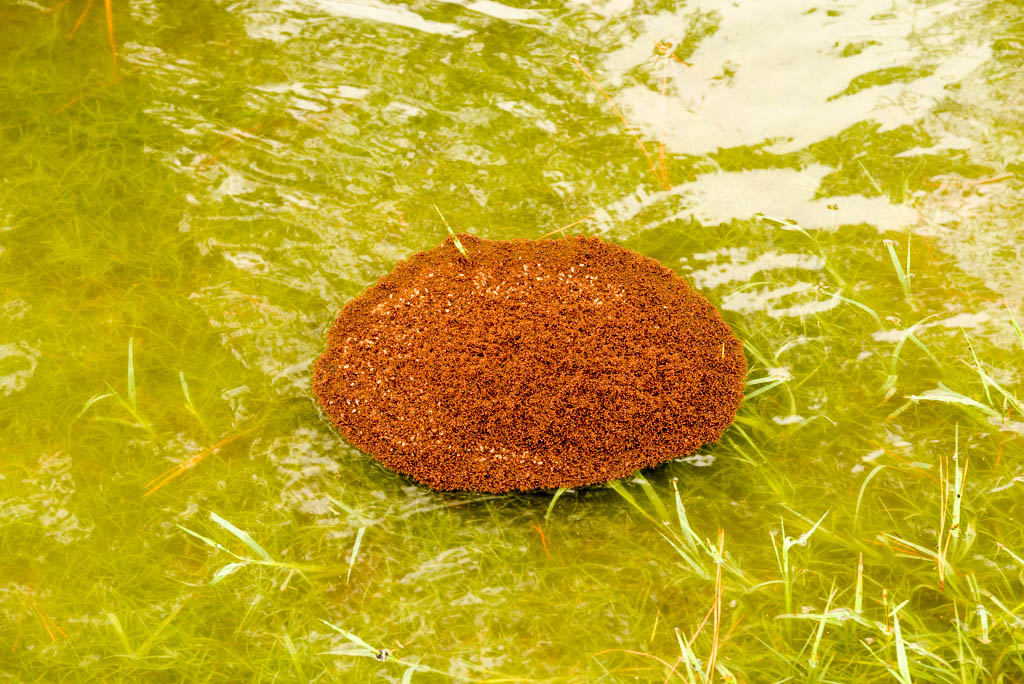
Hurricane Harvey didn’t just bring floodwaters to Texas; it also spread a plague of stinging ants.
Red imported fire ants are highly aggressive pests that have invaded the southern United States. These ants are particularly adept at surviving floods – a strategy they developed in the wetlands of their native Brazil. When their nests become waterlogged they form rafts, clinging to each other to stay afloat as floodwaters carry them elsewhere. When they make landfall they set up a new home – but landfall for a floating anthill could be a paddle or a rescue skiff leaving the passengers battling swarms of stinging ants. After Hurricane Harvey, pictures of the rafting ants filled the news. Twice Hawaiʻi inspectors have intercepted these ants in shipments bound for the Aloha State, but as far as we know this painful plague has not yet established itself in the Islands.
Fire ants aren’t the only nuisance species spread by hurricane winds and associated flooding.
In 1992, Hurricane Andrew hit Homestead, Florida. The intense winds flattened a reptile collector’s greenhouse, sending baby Burmese pythons flying through the air. Homestead borders Everglades National Park. While most of these airborne serpents probably died, scientists suspect some survived and likely reinforced the existing population of escaped reptiles. Pythons are now one of Floridaʻs biggest pests, both in size and impact. A full-grown python can be 20’ in length and these giants threaten the survival of the endangered Florida panther and other unique wildlife.
Resource managers in Hawaii are worried about a much smaller pest traveling on the winds of hurricanes and storms. Spores from the fungus responsible for Rapid ʻŌhiʻa Death, the disease that has killed ʻōhiʻa trees across 75,000 acres of forest on Hawaiʻi Island, is wind-dispersed. High winds can knock off branches and wound a ʻōhiʻa tree, opening up a site that’s vulnerable to infection—similar to how a wound on your skin exposes you to infection. Rapid ʻŌhiʻa Death was recently discovered in Kohala in September of 2017, only 40 miles from Maui – easily within the distance of a windstorm. Resource managers are increasingly worried that Maui’s native forests could be next.

Intense storms can also damage an otherwise intact rainforest, rendering the forest ecosystem more vulnerable to invasive plants. Hurricanes and storms can fell big canopy trees, opening up a gap that gives a fast-growing invader the light and space it needs to get a foothold. Many of those invaders are shallow-rooted and conducive to landslides, exacerbating the problems hurricanes cause.
Exotic species and the altered forest that they form may not be able to weather the winds as well as an intact rain forest. Storm impacts are amplified as a result. In 2014, Tropical Storm Iselle struck areas of Hawaiʻi Island where albizia trees dominated the landscape. These invasive giants fell hard, taking down power lines and blocking roads. The clean-up took months; albizia became a poster child for invasive species problems.
The onset of climate change underscores the importance of bolstering the health of our rainforests. Tropical ocean temperatures are expected to increase and with that rise comes more intense storms and hurricanes. Considering widespread invasive plants established at lower elevations, increasing storms could lead to a cycle of increasing forest destruction which will lead to drastic changes in forest canopy structure and composition.
While we can’t control the weather, we do have control over the choices we make in our daily lives and the causes and programs we support. Efforts to eradicate or contain invasive species are important to help the rainforest retain resilience to storms and preserve our quality of life.
You can help by using non-invasive plants in your landscaping, plants that will not exploit the damage caused by tropical storms, and keeping an eye out for invasive species like fire ants. Avoid the temptation to plant fast-growing, exotic trees. Support organizations dedicated to protecting our islands from invasive species. For the long term, support policies and programs that will reduce our carbon footprint and promote sustainability. Our individual actions do make a difference—just about any effort is worth the trouble if we can avoid rafting ants and flying snakes.
Lissa Strohecker is the public relations and education specialist for the Maui Invasive Species Committee. She holds a biological sciences degree from Montana State University. Kia’i Moku, “Guarding the Island,” is prepared by the Maui Invasive Species Committee to provide information on protecting the island from invasive plants and animals that can threaten the island’s environment, economy, and quality of life.
This article was originally published in the Maui News on October 8th, 2017, as part of the Kia‘i Moku Column from the Maui Invasive Species Committee.
Read more Kiaʻi Moku articles.
